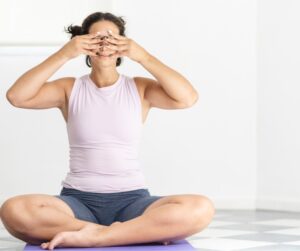Table of Contents
ToggleWhat is Bhramari Pranayama?
Bhramari Pranayama is a relaxing breathing technique that connects us to our inner nature. It may be used as a preparatory for meditation. The word “Bhramari” means bumblebee. Another name for this type of pranayam is bee breathing. The name originates from the soft humming during exhalation sound at the back of the throat, which resembles a bee’s buzz.
This pranayama practice helps control breathing and regulate the nervous system, improving mental and emotional health. One main characteristic of this pranayama is that it reduces any distraction caused by our sensory organs.
This pranayama practice aims to assist you in controlling your breathing and lowering the amount of sensory input your body receives. This has the extraordinary ability to regulate the nervous system and improve mental and emotional health.
Science Behind Bhramari Pranayama
Studies show that Bhramari pranayama directly affects the autonomic nerve system, which helps control blood pressure and heart rate. The relaxation response mostly depends on the vagus nerve, stimulated by the vibrations produced during this Pranayama.
The healing properties of the breathing technique elevate alpha brainwaves, which are linked to a calm and concentrated mental state and promote mood and cognitive performance. It also boosts mind-body awareness and facilitates both emotional and physical recovery.
Physical Benefits of Bhramari Pranayama

Bhramari Pranayama has advantages that go beyond just relaxation and stress alleviation. This effective method offers several advantages for the body and mind. Let’s examine a few of its main advantages:
Regulates the nervous system
It is said that bumblebee breathing helps in the balanced functioning of the neurological processes. The larynx and pharynx muscles twitch in response to the generated humming sound. This movement activates the vagus nerve, essential in controlling the parasympathetic nervous system. The rest and digest response triggered by the parasympathetic nervous system lowers the heart rate, relaxes the muscles of the body, and fosters feelings of calm.
Promotes heart health
In addition to calming the nervous system, Bumblebee Breath can significantly enhance heart health. This Pranayama effectively controls the sympathetic nervous system, which may speed up the heart rate during stressful situations.
This, in turn, lowers hypertension and high blood pressure. Prolonged exhalations, regulated abdominal breathing, and concentrated attention promote healthy heart functioning.
Mental Benefits of Bhramari Pranayama
Reduces stress and anxiety
Bhramari Pranayama can lower stress and anxiety levels. Controlled exhalation paired with the humming sound helps to direct the attention away from unpleasant thoughts and ideas and bring the focus to the present moment. This leads to a therapeutic and peaceful sensation.
Enhanced Concentration
Consistently performing this pranayama improves attention and concentration. It helps us focus on the work by minimizing mental noise and chatter, enhancing daily productivity and cognitive performance.
Relieves insomnia and improves sleep
Bhramari Pranayama might be helpful if you have trouble falling asleep at night or relaxing after a long day. The relaxation response is triggered by deep breathing, preparing the body and mind for good sleep. Including this exercise in your daily night routine will enhance quality sleep and reduce insomnia symptoms.
How to do Bharamari Pranayama
To get started, follow these steps to practice Bhramari pranayama:

- Select a pleasant, quiet area and sit comfortably
- Close your eyes, lengthen the spine, and relax your shoulders.
- Press the index fingers on the ear cartilage slightly above the earlobes.
- Inhale deeply through the nose
- Exhale and make a soft humming sound in your throat.
- Pay attention to the sound and the sensations it elicits.
- Practice 5 to 10 rounds of bhramari pranayama. Gradually increase to I0 to I5 minutes. One may also practice for up to half an hour if experiencing extreme mental strain or anxiety.
Variation of Bhramari Pranayama
Bharmari pranyama with Shanmukhi mudra
In Shanmukhi Mudra, the fingers close the six gates of perception gently, including the eyes, nose, and ears. Place your thumbs on the earlobes, middle fingers on the sides of your nose, ring fingers on the corners of the lips, little fingers on the chin, and index fingers on your closed eyelids.
Who Should Not Practice Bhramari Pranayama?
It is entirely safe to practice Bhramari Pranayama. However, before practicing the pranayama, there are a few things to remember. A few conditions that exclude bumblebee breathing practitioners are excessively high blood pressure, sinus, or severe ear infections.
It is recommended that expected mothers practice Bhramari Pranayama under the supervision of a trained yoga instructor. Certain adjustments could be required to account for the changes in the body that occur during pregnancy.
Anybody with a medical condition must always speak with a healthcare professional or consult a yoga school or a yoga teacher before starting a new breathing or exercise regimen.
If you’re searching for a technique to reduce tension and reestablish your connection with the inner self, then Bhramari Pranayama is an effective practice. Amid distractions and pressures around us, the Bhramari pranayama helps us take a step back and restore ourselves.

